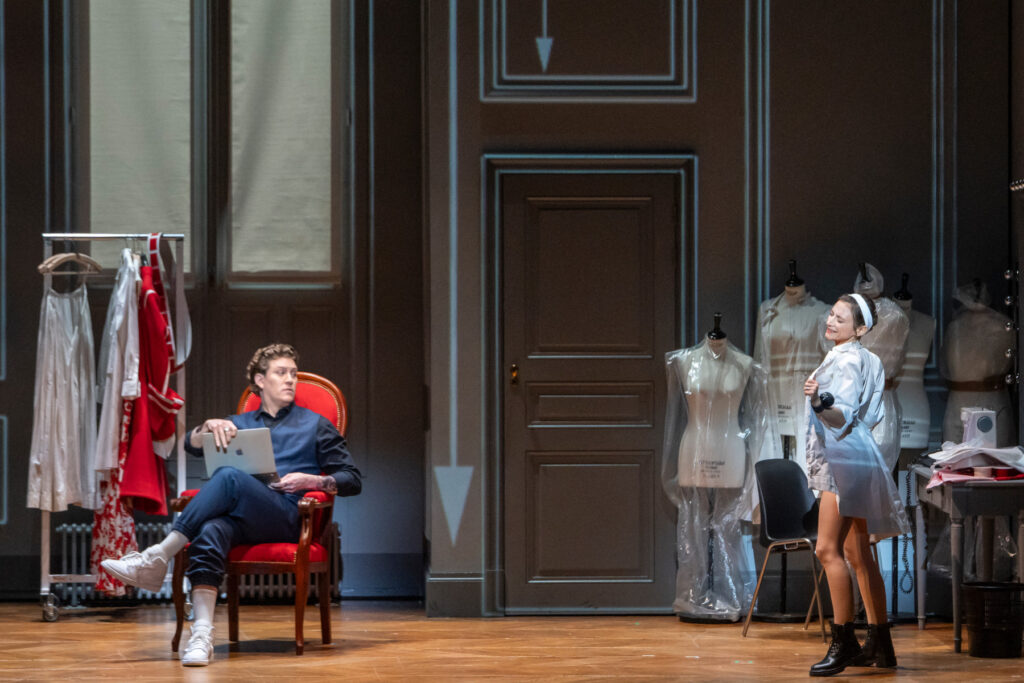I sometimes wonder if directors actually like music or even the operas they agree to stage. This reboot of Netia Jones’s 2022 Les Noces de Figaro is a reminder of her take on Mozart and Da Ponte and her preoccupation with sexual harassment. Of course, her intentions are not without foundation, but hers is a single-minded feminist interpretation that has already raised a few eyebrows.
She situates the action within the backstage of a theatre, specifically the present-day Opéra Garnier, which serves to reflect society with all its various abuses and male dominated power struggles. The resulting production is a joyless affair that removes the opera’s witty critique of class structure, often considered to have been a harbinger of the French Revolution. Her focus on abuse rather than class tensions virtually removes any of the work’s wit shared by its music and character interaction. With Jones’s interpretation, it seems we are no longer allowed to laugh at misdemeanours. One fears what this British director might do with Don Giovanni. At the close of Les Noces, where the Count is normally forgiven by his wife, Jones rejects any reconciliation (one of the most moving scenes in opera) and he stands alone on the stage a broken man. All this, despite the music emphatically indicating a new beginning, compassion explicit. Words and music are upended, and those evocative rising intervals ignored merely to satisfy a bias that men get what they deserve.

Elsewhere, we sense Jones’s humourless viewpoint. During the Overture the Count looms over a ballerina with nefarious intentions; and later Don Basilio attempts to give a singing lesson to a young girl dressed only in a towel. Susanna – a wardrobe mistress – reveals her bare top half to Figaro – a wigmaker – in a needless moment that objectifies her and suggests a submissive character, not the strong personality conceived by da Ponte and Mozart. Not least, it undermines Jones’s own contention that drives her staging. And while, of course, the Count’s claim to feudal rights over newlyweds is to be condemned, where is the fun in all the scheming that prevents this? At the start of Act 4 we see Barbarina leave the Count’s dressing room with a ripped skirt, her cavatina, “L’ho perduta” implying, in this instance, that she’s just been ravished. Jones’s finger-wagging ultimately reduces our empathy with Mozart’s characters, where deception and desire, once comical is now roundly censured.
Sets and costumes are artfully conceived. Acts 1 and 2 reveal a series of dressing rooms before a vast costume department (multiple stairways and racks of clothing) envelops the stage for the beginning of Act 3, which later becomes a dance studio where members of the Paris Opera ballet school are training. And the building itself, in all its opulence with chandeliers and mirrors, becomes a backdrop for the final act, but much of the action takes place on a bare stage and the wedding between Figaro and Susanna appears to be all but cancelled. The couple are in modern dress, while their masters are in 18th century attire in the role of opera singers. Cherubino sports a red tracksuit, while Barbarina is a member of the choir du ballet. So far, these ideas make sense, but Jones’s imagination deserts her with her use of the chorus which stand in rows, taking up positions like a choir performing an oratorio. Their first appearance becomes a sort of union demonstration in which they put up posters with an insistent ‘NO’ against sexual harassment.

Fortunately, the international cast is this production’s saving grace. As Susanna, Sabine Devieilhe has a natural stage presence and a soprano voice perfect for Mozart, her Act 4 aria ‘Deh vieni’ beautifully rendered. Her dim-witted Figaro is safe in the hands of Gordon Bintner who resolutely delivers ‘se vuol ballare’. Christian Gerhaher impressed as the predatory Count, giving a well-defined portrayal that elicited our sympathy (if not Jones’s) at the end. His Act 3 rage aria was a highlight. Lea Desandre was ideal as Cherubino, totally convincing as a slouching adolescent. Her two arias are nicely turned out, with plenty of frustration in ‘Non so più’ and ardour in ‘Voi che sapete’. As the Countess, Hanna-Elisabeth Müller is a tragic figure, her two laments touching for their depth of feeling, ‘Dove sono’ prompting extended applause.
Of the smaller roles, Ilanah Lobel-Torres commands the stage as Barbarina and, in just a handful of lines, sings with effortless assurance to deliver an enchanting cameo. Monica Bacelli delivers a scheming then motherly Marcellina, well partnered by James Cresswell’s sonorous Dr. Bartolo. No less thoughtfully conceived are Leonardo Cortelllazzi’s vain music-master Don Basilio and Franck Leguerinel’s eagle-eyed gardener Antonio.

Below stairs (as it were), the Orchestre de l’Opéra national de Paris under Antonello Manacorda got into its stride after a lacklustre Overture and brought some Mozartian magic, shapely woodwind playing and well-judged tempi. In short, this production may not be everyone’s cup of tea, but the music-making is glorious.
David Truslove
Les Noces de Figaro
Music: Wolfgang Amadeus Mozart
Libretto: Lorenzo Da Ponte after Beaumarchais Le Mariage de Figaro
Cast and Production Staff:
Figaro – Gordon Bintner; Susanna – Sabine Devieilhe; Count Almaviva – Christian Gerhaher; The Countess – Hannah-Elizabeth Müller; Cherubino – Lea Desandre; Dr. Bartolo – James Cresswell; Marcellina – Monica Bacelli; Don Basilio – Leonardo Cortelllazzi; Barbarina – Ilanah Lobel-Torres; Antonio – Franck Leguerinel
Director – Netia Jones; Lighting – Lucy Carter; Movement – Sophie Laplane; Conductor – Antonello Manacorda; Orchestre et Choeurs de l’Opéra national de Paris.
Palais Garnier, Paris; 18 November 2025
All photos © Franck Ferville